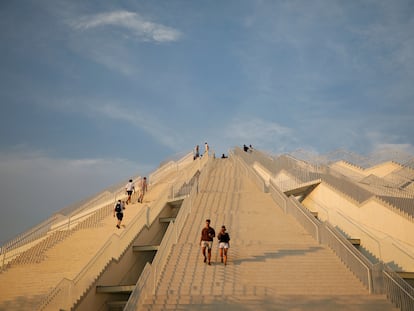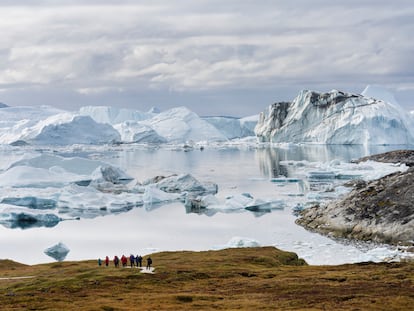24 hours in Seville: A guided walk through art and literature
A tour of the southern Spanish city on the trail of famous local poets like Bécquer and classical painters like Velázquez
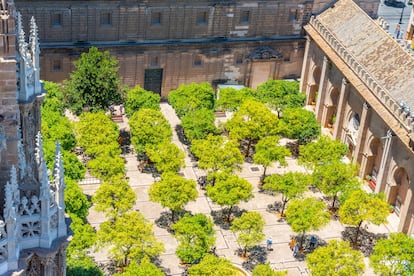
Few cities in the world combine as much charm, art and history as Seville, in Spain’s southern region of Andalusia. It has been immortalized by some of the best writers of all time: Miguel de Cervantes in his Exemplary Novels, Francisco de Quevedo in El Buscón. It is also the city of Antonio Machado and Luis Cernuda, and of Federico García Lorca, who stayed in the Alcázares in 1935. Seville’s streets were stepped on by Lord Byron, Washington Irving, Rubén Darío and Thomas Mann, who came to visit in 1923 and wrote: “I will always remember the day of the Ascension in Seville, with the mass in the Cathedral, the magnificent organ music and the bullfight in the afternoon.”
We will allude to that artistic side of Seville on this route, evoking what Théophile Gautier said after staying on Sierpes Street in 1840: “It is a large, diffuse, modern, happy, laughing, lively city. (...) unconcerned by yesterday, even less so by tomorrow; she is but the present.”
9.00 a.m. Bécquer at María Luisa Park
During the period of the discovery of the Americas, Seville was the economic and political capital of the world. The city illustrated its own global centrality with the Ibero-American Exposition of 1929, conceived to twin Spain with Latin America, the United States, Portugal and Brazil. For this purpose, 117 buildings were built, of which 25 are preserved (today converted into political or academic institutions, dance centers or consulates), which were located in the surroundings of María Luisa Park. The famous Plaza de España was built there, and right across, hidden among the foliage, are 48 busts of great personalities in Spanish history such as Quevedo or Velázquez. The monument to Gustavo Adolfo Bécquer, the poet of Rhymes and Legends, was the brainchild of Serafín and Joaquín Álvarez Quintero, the dramatist brothers, who financed the project through their 1910 play La rima siempre.
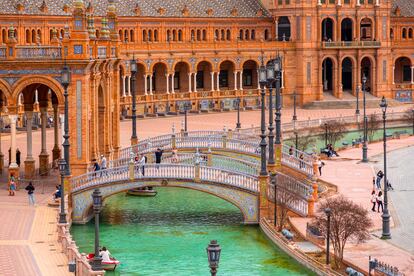
Bécquer’s birthplace can be located in the San Lorenzo neighborhood, specifically at number 28 Barajas Street. There is a plaque commemorating the birth of the writer, on February 17, 1836, and in addition, his tomb can be visited in the Pantheon of Illustrious Sevillians (access through the School of Fine Arts), along with that of his brother, the painter Valeriano Bécquer.
10.00 a.m. Archived history
A 20-minute walk from the park takes us to the General Archive of the Indies (2), built in the mid-17th century under the reign of Philip II, to be a market for merchants Under Charles III it was adapted to store documentation related to Spain’s overseas possessions between the 15th and 19th centuries. There is preserved the Perpetual Almanac of Abraham Zacuto, which allowed navigators to calculate latitudes: it is the same copy that Christopher Columbus consulted. Nearby is the Municipal Archive (3), which preserves documentation from the 13th century, when the city was incorporated into the Crown of Castile. The Colombina Chapter Library (4), in the Patio de los Naranjos of the cathedral and established in 1539 thanks to the impressive bibliographic legacy of the scholar Hernando Colón, son of the discoverer, would complete a visit of great interest for scholars of local and universal history.
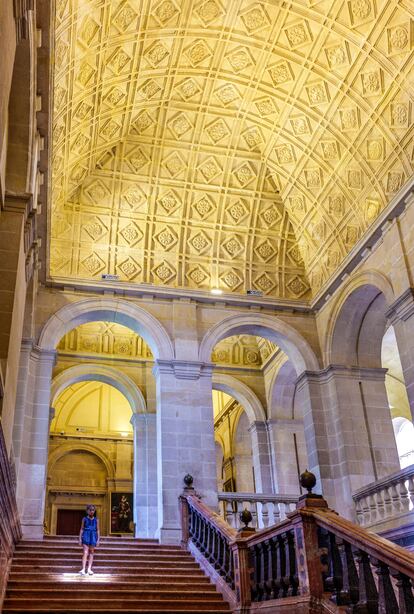
11.00 a.m. Museum of Fine Arts
A stone’s throw away is the Museum of Fine Arts (5), founded in September 1835 inside the old 17th-century convent of Merced Calzada. Due to its imposing structure and the quantity and variety of medieval and baroque art, sculptures and landscapes, as well as 19th-century paintings, it is one of the most attractive museums in Spain. Masterpieces such as portraits by El Greco and Velázquez, not to mention The Apotheosis of Saint Thomas of Aquinas by Zurbarán, and the pictorial group that Murillo painted for the church of the Capuchin Convent, are just some examples of what can be found there.

Continuing with art, it is possible to visit Velázquez’s birthplace, in the heart of the Moorish neighborhood of Seville. In the 1970s it was an art gallery and in the 80s the workshop of the couturiers Victorio and Lucchino. It was in 2018 when it was opened to the public as the Casa Natal de Velázquez (Calle Father Luis María Llop, 4) (6). It is also possible to visit the Casa de Murillo (Calle Santa Teresa, 8) (7), which offers a peek at what Seville was like in the 17th century, following in the artist’s footsteps.
2.00 p.m. Lunch and Andalusian tradition
From the Museum of Fine Arts we can approach the street called Calle Acetres (8), in the Santa Cruz neighborhood. At number six there is a plaque dedicated to the poet and literary critic Luis Cernuda, who lived there in the 1920s and who spoke about it in his book Ocnos (1942). Then, a few minutes away, there are two highly recommended places to eat: Casa Robles (Calle Álvarez Quintero, 58) (9) has boasted haute Andalusian cuisine since 1954, it has one of the most extensive wine lists in the city and has received numerous awards. Another classic spot is Donald (Calle Canalejas, 3) (10), founded in 1973 and famous for preparing what is said to be the best ensaladilla rusa in Spain. Another famous restaurant is San Fernando, inside Hotel Alfonso XIII, which specializes in delicacies such as almadraba tuna with Mediterranean herbs and white garlic, and rack of lamb with herb crust and eggplant caviar.
4.00 p.m. Memories of a ‘Machadian’ patio
After lunch, it would be a good idea to visit the Machadian spot par excellence: the Palacio de las Dueñas (12), where the poet Antonio Machado was born in 1875. It was built between the 15th and 16th centuries and at the beginning it was a monastery. One of the tenants and administrator was the father of the author of these famous verses: “My childhood is memories of a patio in Seville / and a clear orchard where the lemon tree matures.” And indeed, it has beautiful patios and gardens, cared for by the Casa de Alba gardeners, where you can admire bougainvillea, jasmine, bignonia, plumbagos, wisteria and hibiscus.

6.00 p.m. Ancient university and modern culture
This whole mix of history, architecture and literature can be further be explored in the place where the schools of Philology and Geography and History are located (13): the University of Seville, built in the 18th century, which at beginning was the headquarters of the first tobacco factory established in Europe. It is an immense enclosure with a Baroque main doorway that includes two central patios, a auditorium and a chapel.
Inside is the Center for Cultural Initiatives (CICUS), which carries out a wide range of activities relating to literature, art exhibitions, theater, musical and audiovisual performances. This institution, together with the Ateneo de Sevilla (14), founded in 1887 with the aim of promoting thought and the literary avant-garde, and where the celebration of the third centenary of Góngora’s death was held, that would bear fruit in the Generation of ‘27, maintain incessant activity through endless events including conferences, round tables and book presentations.
8.00 p.m. Dine and sleep like kings
Very close to the university is one of the most luxurious, history-steeped hotels in all of Europe: the Alfonso XIII (15), designed by the architect José Espiau Muñoz to be the residence of the international dignitaries who visited the 1929 Exposition. The monarch’s idea was to turn it into the most fabulous accommodation on the continent. It maintains its extraordinary elegance of yesteryear - there are tours to get to know it in depth and it even has a small museum. There are 148 rooms, including 22 suites, plus banquet rooms where countless celebrities from the world of politics or entertainment have visited. The hotel has been the setting of movies such as Lawrence of Arabia and the television series Game of Thrones.
But, beyond staying in such a place, commanded by Carlo Suffredini, accustomed to a job that involves diplomatic relations at the highest level, it is possible to enjoy the wonderful American Bar. With a style full of glamor and a 10-meter bar that seems straight out of an old movie, you can taste different cocktails in front of photographs of well-known people who stayed here. And to top it off, what better than to dine on the terrace of the Ena restaurant (homage to Queen Victoria Eugenia Julia de Battenberg), with classic tapas and Iberian sausages as the center of its cuisine, and, furthermore, do it with something priceless: views of the center of the city to say, like Gautier, that Seville is only present.
Sign up for our weekly newsletter to get more English-language news coverage from EL PAÍS USA Edition
Tu suscripción se está usando en otro dispositivo
¿Quieres añadir otro usuario a tu suscripción?
Si continúas leyendo en este dispositivo, no se podrá leer en el otro.
FlechaTu suscripción se está usando en otro dispositivo y solo puedes acceder a EL PAÍS desde un dispositivo a la vez.
Si quieres compartir tu cuenta, cambia tu suscripción a la modalidad Premium, así podrás añadir otro usuario. Cada uno accederá con su propia cuenta de email, lo que os permitirá personalizar vuestra experiencia en EL PAÍS.
¿Tienes una suscripción de empresa? Accede aquí para contratar más cuentas.
En el caso de no saber quién está usando tu cuenta, te recomendamos cambiar tu contraseña aquí.
Si decides continuar compartiendo tu cuenta, este mensaje se mostrará en tu dispositivo y en el de la otra persona que está usando tu cuenta de forma indefinida, afectando a tu experiencia de lectura. Puedes consultar aquí los términos y condiciones de la suscripción digital.
More information
Archived In
Últimas noticias
Most viewed
- Reinhard Genzel, Nobel laureate in physics: ‘One-minute videos will never give you the truth’
- Oona Chaplin: ‘I told James Cameron that I was living in a treehouse and starting a permaculture project with a friend’
- Pablo Escobar’s hippos: A serious environmental problem, 40 years on
- Charles Dubouloz, mountaineering star, retires at 36 with a farewell tour inspired by Walter Bonatti
- Why we lost the habit of sleeping in two segments and how that changed our sense of time
